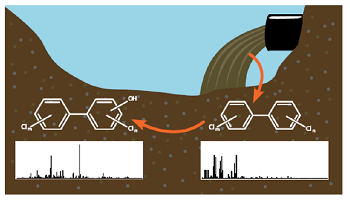Superfund Research Program
Study Sheds Light on Breakdown Products of PCBs in the Environment
View Research Brief as PDF(504KB)
Release Date: 06/01/2022
![]() subscribe/listen via iTunes, download(5.8MB), Transcript(87KB)
subscribe/listen via iTunes, download(5.8MB), Transcript(87KB)
NIEHS Superfund Research Program (SRP) grantees discovered toxic breakdown products of polychlorinated biphenyls (PCBs) in contaminated sediments at proportionally higher levels than found in commercial PCB mixtures. According to the team, these findings point to environmental processes, such as metabolism by animals, plants, or bacteria, in generating the harmful chemicals.
PCBs are persistent environmental pollutants classified as human carcinogens. From 1930 to 1979, PCBs were manufactured as mixtures of individual PCB compounds called Aroclors. Although PCBs were banned in 1979, they still persist in air, water, soil, and sediments, and are still produced as byproducts of some industrial processes.
Measuring OH-PCBs

Although PCB breakdown products — called hydroxylated PCBs (OH-PCBs) — have been previously reported in the environment, measuring them and identifying their sources is difficult due to a lack of analytical standards.
To establish some needed standards, a team led by University of Iowa SRP Center Director Keri Hornbuckle, Ph.D., decided to analyze sediment samples collected from three PCB-contaminated sites: the New Bedford Harbor Superfund site in Massachusetts, the Altavista Wastewater Lagoon in Virginia, and the Indiana Harbor Ship Canal in Indiana.
They used advanced analytical methods, previously developed by the center, and statistical techniques to quantify found chemical compounds. They discovered 937 OH-PCBs and 209 PCBs in the samples. Concentrations of OH-PCBs in sediments varied by site, with the New Bedford Harbor site having the highest levels.
Uncovering Sources
Next the team sought to determine whether OH-PCBs originated from Aroclor mixtures or were generated later in the environment. The team quantified their presence in four commercial Aroclors, which make up more than 99% of those previously sold in the U.S.

They found more OH-PCBs in sediments than expected. In fact, the proportion of OH-PCBs in sediments was at least 30 times higher than PCBs that could be attributed to Aroclors. According to the authors, these results show that the contribution of the original commercial mixtures to OH-PCB contamination in sediments is negligible.
The researchers also observed differences in OH-PCB chemicals at each site. They explained that the age and composition of the sediment and environmental factors like microbial communities, pH, salinity, and water flow play a role in the formation of different OH-PCBs between sites.
The team then identified the predominant OH-PCBs at each site. In New Bedford Harbor a previously unknown compound, 4-OH-PCB52, made up 18% of the OH-PCBs in sediments collected from the site, but less than 1.2% in Aroclors.
Several OH-PCBs found at the study sites can be more toxic than the parent PCB compounds. For example, 4-OH-PCB52 can disrupt hormones by binding to estrogen receptors and is associated with a decrease in thyroid hormone levels. Another breakdown product, 4-OH-PCB2, found at the Indiana Harbor Ship Canal, can be toxic to cells in the brain and liver.
According to the authors, their findings suggest that the breakdown of PCBs into OH-PCBs in the environment poses a significant threat to human and ecosystem health. More studies are needed to fully understand their production, movement, accumulation, and risk to humans.
The researchers have released their study data in a free public data repository.
For More Information Contact:
Keri C. Hornbuckle
University of Iowa
Department of Civil and Environmental Engineering
Iowa City, Iowa 52242
Phone: 319-384-0789
Email: keri-hornbuckle@uiowa.edu
To learn more about this research, please refer to the following sources:
- Saktrakulkla P, Li X, Martinez A, Lehmler H, Hornbuckle KC. 2022. Hydroxylated polychlorinated biphenyls are emerging legacy pollutants in contaminated sediments. Environ Sci Technol 56:2269-2278. doi:10.1021/acs.est.1c04780 PMID:35107261 PMCID:PMC8851693
To receive monthly mailings of the Research Briefs, send your email address to srpinfo@niehs.nih.gov.


